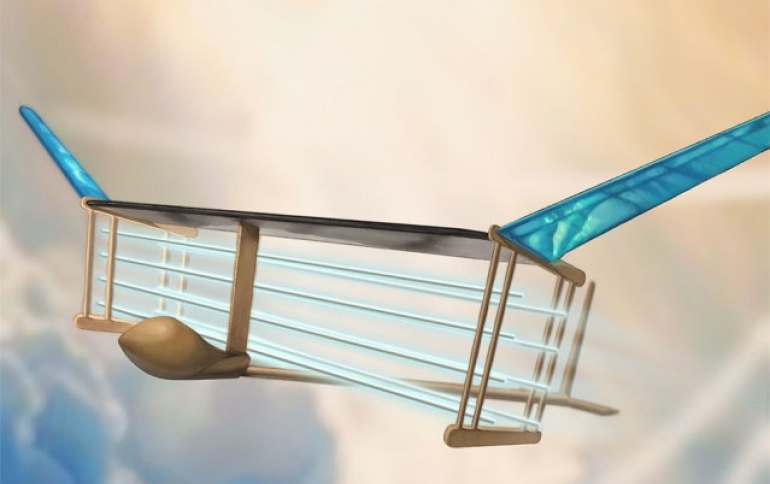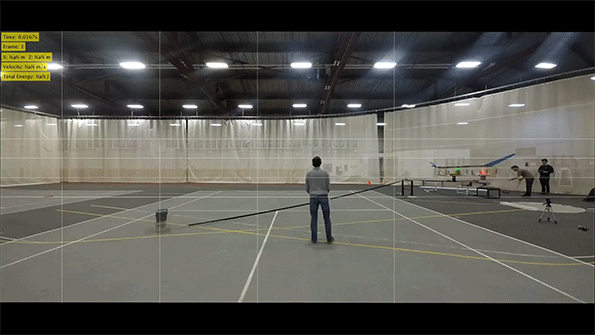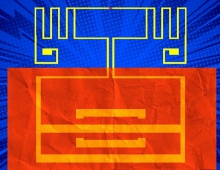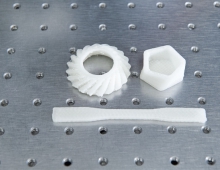
Engineers Fly First-ever Plane Powered by Flow of Ions
MIT engineers have built and flown the first-ever plane with no moving parts. Instead of propellers or turbines, the light aircraft is powered by an "ionic wind" — a silent but mighty flow of ions that is produced aboard the plane.
Unlike turbine-powered planes, the aircraft does not depend on fossil fuels to fly. And unlike propeller-driven drones, the new design is completely silent.
The sustained flight of a plane with no moving parts in the propulsion system has potentially opened new and unexplored possibilities for aircraft which are quieter, mechanically simpler, and do not emit combustion emissions.
Steven Barrett, associate professor of aeronautics and astronautics at MIT, expects that in the near-term, such ion wind propulsion systems could be used to fly less noisy drones. Further out, he envisions ion propulsion paired with more conventional combustion systems to create more fuel-efficient, hybrid passenger planes and other large aircraft.
Barrett came upon "ionic wind," also known as electroaerodynamic thrust — a physical principle that was first identified in the 1920s and describes a wind, or thrust, that can be produced when a current is passed between a thin and a thick electrode. If enough voltage is applied, the air in between the electrodes can produce enough thrust to propel a small aircraft.
For years, electroaerodynamic thrust has mostly been a hobbyist’s project, and designs have been limited to small, desktop "lifters" tethered to large voltage supplies that create just enough wind for a small craft to hover briefly in the air.
MIT team's final design resembled a large, lightweight glider. The aircraft, which weighs about 5 pounds and has a 5-meter wingspan, carries an array of thin wires, which are strung like horizontal fencing along and beneath the front end of the plane’s wing. The wires act as positively charged electrodes, while similarly arranged thicker wires, running along the back end of the plane’s wing, serve as negative electrodes.
The fuselage of the plane holds a stack of lithium-polymer batteries. Members of Professor David Perreault’s Power Electronics Research Group in the Research Laboratory of Electronics designed a power supply that would convert the batteries’ output to a sufficiently high voltage to propel the plane. In this way, the batteries supply electricity at 40,000 volts to positively charge the wires via a lightweight power converter.
Once the wires are energized, they act to attract and strip away negatively charged electrons from the surrounding air molecules, like a giant magnet attracting iron filings. The air molecules that are left behind are newly ionized, and are in turn attracted to the negatively charged electrodes at the back of the plane.
As the newly formed cloud of ions flows toward the negatively charged wires, each ion collides millions of times with other air molecules, creating a thrust that propels the aircraft forward.
The team flew the plane in multiple test flights across the gymnasium in MIT’s duPont Athletic Center. They flew the plane a distance of 60 meters (the maximum distance within the gym) and found the plane produced enough ionic thrust to sustain flight the entire time. They repeated the flight 10 times, with similar performance.

"This was the simplest possible plane we could design that could prove the concept that an ion plane could fly," Barrett says. "It’s still some way away from an aircraft that could perform a useful mission. It needs to be more efficient, fly for longer, and fly outside."
The new design is a "big step" toward demonstrating the feasibility of ion wind propulsion, according to Franck Plouraboue, senior researcher at the Institute of Fluid Mechanics in Toulouse, France, who notes that researchers previously weren’t able to fly anything heavier than a few grams.
Barrett’s team is working on increasing the efficiency of their design, to produce more ionic wind with less voltage. The researchers are also hoping to increase the design’s thrust density — the amount of thrust generated per unit area. Currently, flying the team’s lightweight plane requires a large area of electrodes, which essentially makes up the plane’s propulsion system. Ideally, Barrett would like to design an aircraft with no visible propulsion system or separate controls surfaces such as rudders and elevators.
Of course, the research was supported, in part, by MIT Lincoln Laboratory Autonomous Systems Line, the Professor Amar G. Bose Research Grant, and the Singapore-MIT Alliance for Research and Technology (SMART). The work was also funded through the Charles Stark Draper and Leonardo career development chairs at MIT.






















The MIT glider is not the first ever aircraft to carry its power supply using ion propulsion as was claimed. The "Self Contained Ion Powered Aircraft" is the first in history. It has a US Patent No. 10,119,527, effective from 2014, It can take off vertically and doesn't need large wings or a catapult to launch. It is propelled solely by ions.